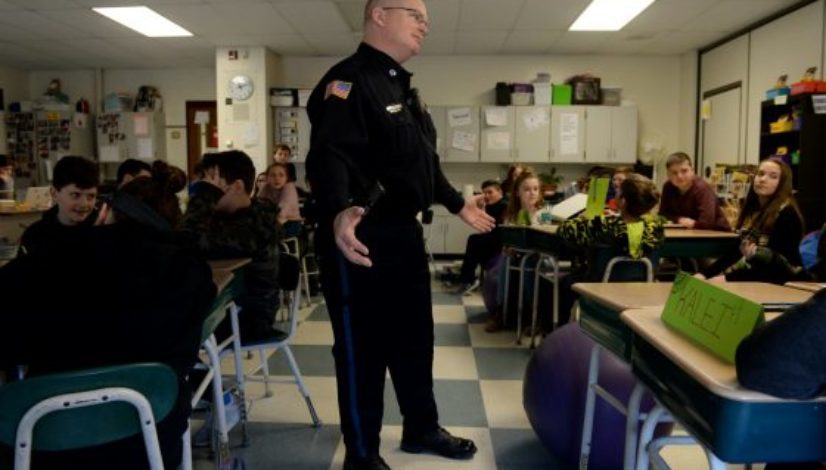Marijuana is legal, but D.A.R.E. sticks to its old-school approach
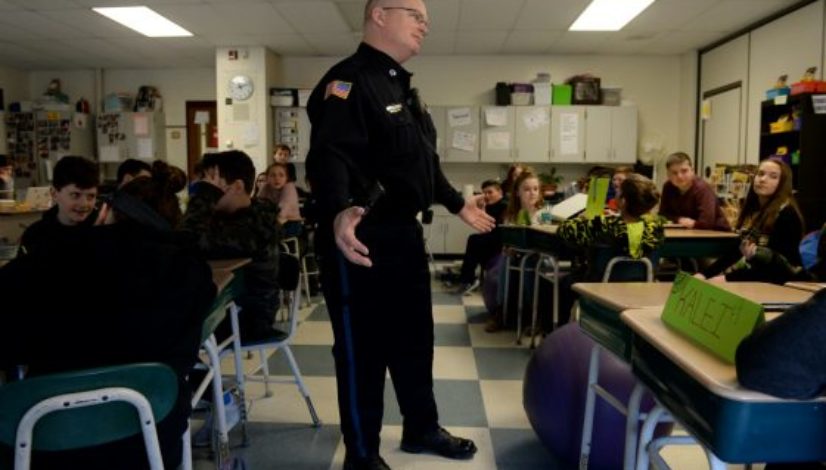
Published: Feb 26, 2018, 5:00 am • Updated: Feb 26, 2018, 2:14 pm
By Jessica Contrera, The Washington Post.
WEST BRIDGEWATER, Mass. — The class had covered bullying, internet safety and good decision-making, and by February, Officer Thaxter could see that the sixth-graders were ready. The morning bell rang. The 11- and 12-year-olds scooted their chairs closer to their desks, looking up at a dry-erase board where their teacher had written the agenda for the day: “D.A.R.E.”
The lights went off, and the projector went on.
“Today,” Officer Thaxter said, “we’re going to talk about marijuana.”
For 16 years, every elementary school student in this small town in Massachusetts has learned about drugs from Kenneth Thaxter. But this year, his lesson needed to change, and he was about to find out whether the students knew why.
“What do you know about marijuana?” he asked.
“It’s a drug,” said a boy named Jack.
“There are different names for it,” said Cassidy.
“There is medical and legal,” said Luke.
“It could actually save your life,” said Chelsea.
“OK, very good,” Thaxter said, and he began to explain.
Massachusetts had become one of eight states to legalize recreational marijuana, and in just a few months, anyone over 21 would be able to purchase it at dispensaries nearby. This, he thought, was a confusing message to send to kids. They’d grown up knowing that drugs are bad. Now they were hearing from older siblings and maybe even their parents that weed is just a plant, and plants are good. It was up to Thaxter to convince them not to try it.
“People get high. That’s the reason people like to smoke, because they get a feeling of euphoria. That is what is reported to me — I don’t smoke,” he told the class. “But there’s also a bunch of other short-term effects.”
He pointed to a list on the screen. Difficulty concentrating. Trouble problem-solving. Loss of coordination and motor skills.
“You would get bad grades,” said a student named James.
“Very good,” Thaxter said. “You guys know Mrs. Wenzel’s science class is no joke. If you’re not paying attention, you’re going to miss out.”
It was exactly the kind of lesson that DARE has officially distanced itself from. The police-run program on “Drug Abuse Resistance Education” was seemingly everywhere in the 1980s and ’90s.
Then multiple studies showed that it did nothing to stop kids from doing drugs. In the 2000s, states slashed it from their budgets. It revamped its curriculum to focus less on drugs and more on smart decision-making. Still, it’s a shadow of its former self. In Massachusetts, which once had 800 DARE officers, 140 remain, including the one now asking his students: “Who likes roller coasters?”
Related: Just say no to D.A.R.E. — starting a better conversation about youth drug prevention
Hands shot up around the room.
“You get up to the top, right before you go over the edge, that’s your body creating endorphins,” Thaxter said. “If you are using drugs to create endorphins, rather than doing it naturally, it’s very dangerous.”
He clicked to a slide titled, “What is addiction?”
And here was the core of his job. Was he going to persuade the kids to never smoke weed? To “Just Say No” forever? Unlikely. But there was a far bigger drug problem outside these walls that he was hopeful – desperate, really – to do something about.
“When your body needs and craves a drug, and doesn’t get the drug, you become sick,” he explained.
Chelsea raised her hand. “Like if you use too much pills, you can overdose?”
“Yes,” Thaxter said. Prescription pills had started the problem. Then it was heroin and fentanyl and carfentanil, the opioids that killed 1,997 people in Massachusetts last year, some of them here in West Bridgewater. Overdoses had become an expected part of Thaxter’s shifts as a patrol officer. His colleagues had responded to one just the night before. In the next 48 hours, there would be two more.
Another hand went up. He always encouraged the students to share stories, as long as they said “someone I know” instead of the person’s name. This student wanted to tell the class how someone she knew had stolen money to pay for drugs.
“Yes, people become desperate,” Thaxter said. “That’s what addiction looks like.”
“Someone I know, he overdosed and he killed himself,” the next sixth-grader said. Her dad had told her that his best friend was now gone. She kept that part to herself.
“I know someone, and he did drugs and stuff, and now he is homeless,” said another. Her parents had told her that she just wouldn’t be seeing her uncle anymore.
Thaxter nodded as he listened, saying “OK,” and “Wow,” and “That is hard.” His job was to ensure that none of these preteens would ever become like the “someone” they knew. He didn’t actually think that they would be trying heroin any time soon. But marijuana, maybe. If a kid was willing to try weed in the sixth grade, Thaxter wondered, what would he be doing at 19 or 20?
“Drugs have touched all of us. Everybody here could probably raise a hand,” he said, trying to get the students back on track. “So, here’s the thing. The teen brain is under construction.”
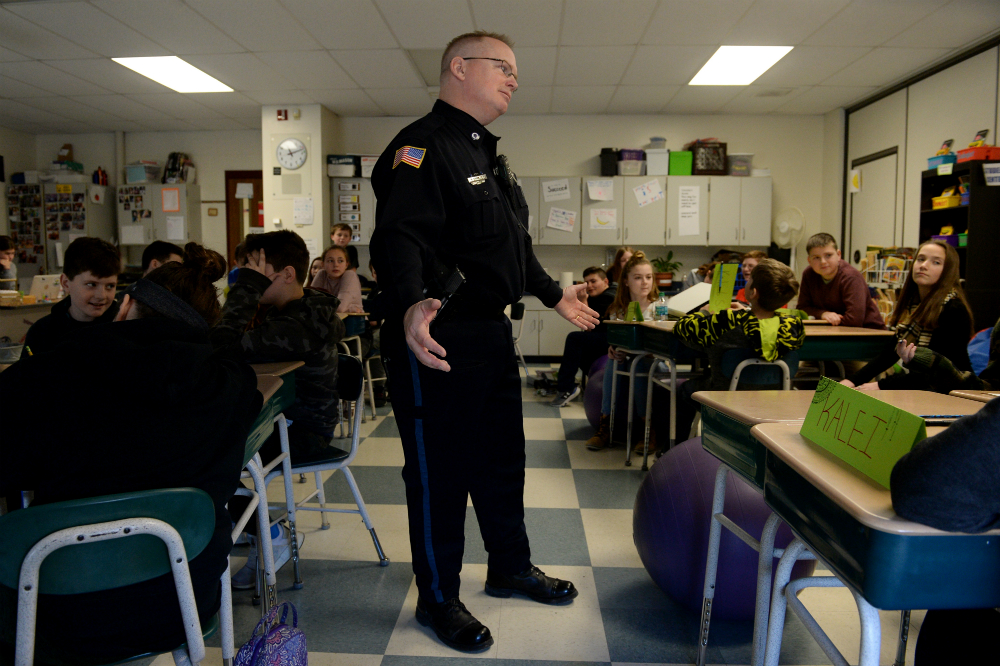 Thaxter talks to a sixth-grade class at Howard Elementary School about the perils of drug use. Because of the opioid crisis, many of the students are already familiar with the consequences of drug abuse. (Jamie Cotten/For The Washington Post)
Thaxter talks to a sixth-grade class at Howard Elementary School about the perils of drug use. Because of the opioid crisis, many of the students are already familiar with the consequences of drug abuse. (Jamie Cotten/For The Washington Post)
He remembers the first overdose he responded to with Narcan, the nasal spray hailed as a lifesaving antidote to opioid overdoses. It was five years ago, when rampant abuse of the drugs still felt like something that happened in big cities, not “little bedroom communities,” as Thaxter called this one. The woman lying unconscious at his feet was a respected health-care provider at the local hospital.
“What happened?” he remembers her asking when she was revived.
“Hon,” he said, “you overdosed.”
Now every police cruiser and firetruck in town is equipped with Narcan, and soon it will be in all the schools. That’s how a drug epidemic feels in West Bridgewater, population 7,000. It isn’t junkies on the side of the road, or skyrocketing crime – but if you know where to look, it’s everywhere.
When Thaxter arrives at the police station in the mornings, there are fewer shoes lined up outside the cells – a sign not that fewer people have been arrested, but that the officers have taken them straight to the hospital, afraid that they will overdose.
His colleagues come back from their days off with stories of trying to go about their lives — getting gas, picking up their dry cleaning — when they glance into the cars in the parking lot and realize that they need to rescue someone.
Related stories
- Seeking opioid crisis answers at summit, Pete Sessions waged war against marijuana
- Do medical marijuana laws reduce opioid overdoses? A new study adds a layer of nuance.
- Medical marijuana conquered my 30-year opioid addiction, Florida man says
- Op-ed: Jeff Sessions thinks aspirin helps severe pain. He’s wrong
- New Mexico lawmakers eye marijuana in fight against opioids
Thaxter has made a habit of reading the obituary pages, looking for young faces.
“It almost looks like we’re at war,” he says. “I don’t ever remember seeing so many obituaries for people in their 20s. The picture, you can tell, they’re totally healthy and vibrant, and then it will say, ‘Died suddenly at home.’ ”
He calls his 21- and 26-year-old sons, who live in New York and California. “Someone from your class,” he’ll tell them.
When one of his former students overdoses, he visits Schools Superintendent Patty Oakley. “Guess who,” he’ll say.
“Ninety-nine percent of the time, they were really successful kids in school and had a bright future,” Oakley says. Some are buried near her husband, who died a few years ago at 50. That no longer seems to her to be a young age to go.
Now her schools are filled with people trying to make sure that others don’t end up in that place. The teachers who know to look out for parents who might be high when they pick up their kids. The counselors who listen to students say, “My dad was in the bathroom for a long time and then the police came,” or the hardest thing to hear: “My mom says if I talk to you they are going to take me away from her.”
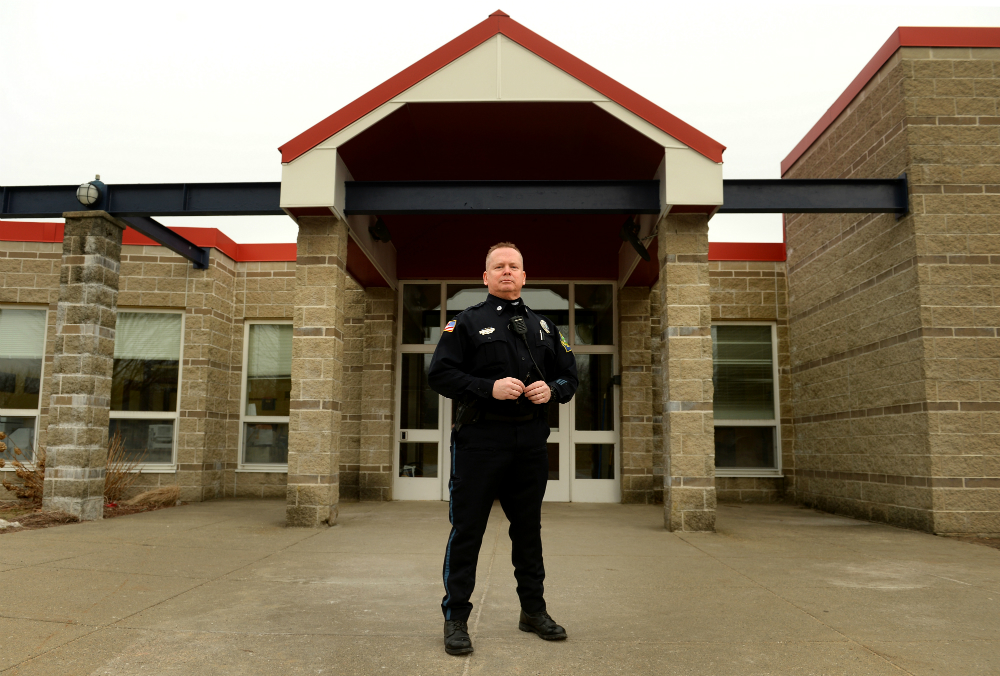 Thaxter stands outside Howard Elementary. About 40 cities and towns in Massachusetts still support the DARE program, but where there were once 800 officers, only 140 remain today. (Jamie Cotten/For The Washington Post)
Thaxter stands outside Howard Elementary. About 40 cities and towns in Massachusetts still support the DARE program, but where there were once 800 officers, only 140 remain today. (Jamie Cotten/For The Washington Post)
“You want to blame something, blame MTV,” the president of Massachusetts DARE told a Boston Herald reporter in 1997. The country was in the middle of a contentious debate over its best-known drug-reduction effort. Study after public health study had concluded that DARE did not decrease drug use among students, and may have even increased it. Politicians and police argued that the program’s benefits, such as familiarizing students with law enforcement, couldn’t be quantified.
The Herald reporter went to a Massachusetts high school to ask students what they thought. The article began with a cigarette-smoking teen named Jessica, who still had the T-shirt she’d received when she graduated from DARE in elementary school — but she had altered it so the letters now stood for “Drugs Are Really Exciting.”
By 2002, Massachusetts had eliminated $4.3 million in funding for the program. That same year, the West Bridgewater chief of police called Ken Thaxter into his office and said, “You have kids, right?” and with that, he became the town’s DARE officer.
Nationally, the program scrambled to fix itself. The curriculum was overhauled. DARE’s mascot, Daren the Lion — chosen in the ’90s, when “The Lion King” was really popular — stayed the same, but what he preached changed. By 2010, DARE had taken the word “drugs” out of its mission statement; the program’s goal is now to “teach students good decision making skills to help them lead safe and healthy lives.”
But last summer, when DARE leaders met in Texas, their highest-profile speaker was fonder of what the program used to be. “DARE is the best-remembered anti-drug program,” Attorney General Jeff Sessions told the officers. “Your DARE team is ready to meet this next challenge. Just like you did in the 1980s and ’90s.”
Related: A brief history of D.A.R.E., the ’80s anti-drug program Jeff Sessions wants to revive
Dominic DiNatale, the current head of Massachusetts DARE, heard about the speech but didn’t watch it or read it. In the past year, his state has been working to introduce marijuana retail sales and combat the opioid epidemic all at once. Some districts that had eliminated their DARE programs contacted him, asking what it would take to get it back.
With no state funding, he answers, it frequently requires a local police department, which may already be low on resources, to be willing to forgo a patrol officer. It requires principals who are under pressure to get students to pass standardized tests to give up teaching time.
The glory days of DARE, it seemed to DiNatale, were long gone. The program’s success would come down to the DARE officers who were left.
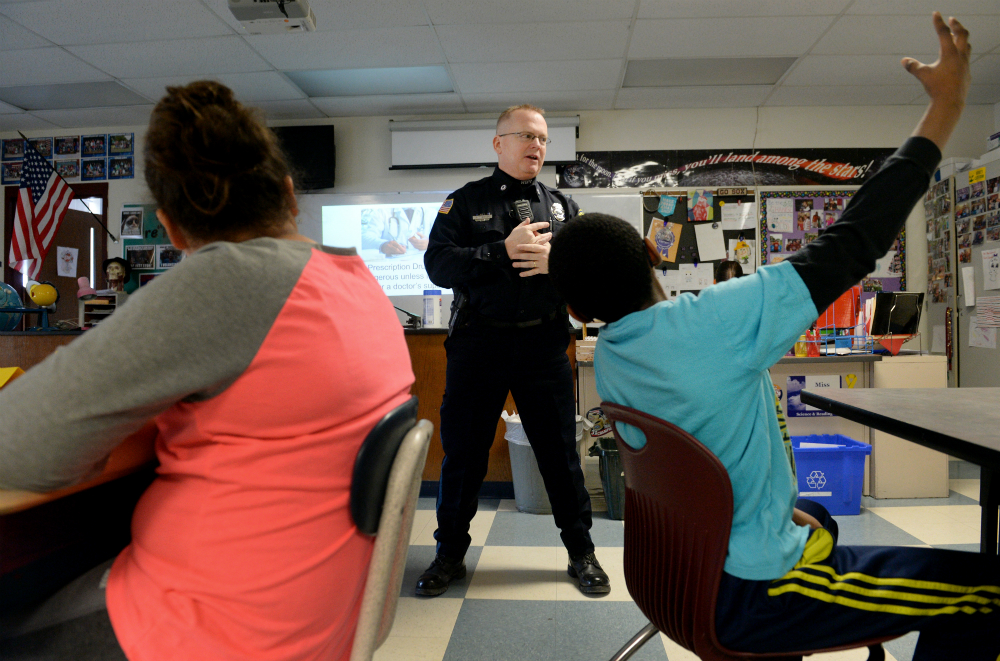 The national DARE program has dropped any mention of drugs from its mission statement, but not Thaxter. “It almost looks like we’re at war,” he says of the opioid crisis in his community. (Jamie Cotten/For The Washington Post)
The national DARE program has dropped any mention of drugs from its mission statement, but not Thaxter. “It almost looks like we’re at war,” he says of the opioid crisis in his community. (Jamie Cotten/For The Washington Post)
“Here’s the problem,” Officer Thaxter told the students at the end of his lesson. “You’re at a party. Some of the kids there are smoking marijuana. OK? Nobody has really asked you to try it, but it’s available. What do you do?”
He paced at the front of the room while the class worked in groups to figure it out. They had seemed to get it when he explained how marijuana could be used as a medical treatment — but only when prescribed by a doctor, and not until they were 21. They’d nodded when he’d projected pictures of beer, cigarettes and skydiving and explained that just because something was legal didn’t mean that it wasn’t dangerous. He promised them that he would do a whole class on opioids, and then they could share more stories. Some of them, he could see, had been forced to grow up too fast. Some still had lots of growing up to do.
“I would run for the hills,” a boy named Josiah told a group in the corner of the classroom.
“What if it’s like, the last-day-of-school pool party?” asked Chelsea.
“Push them into the pool,” Josiah said.
“They’re high,” said Rachel. “They wouldn’t be able to swim, and they would drown, and then you just committed a murder.”
Her friend Kadence laughed. “I think,” she said, “you just say no, we’re 11.”
“You could throw it in the trash,” Josiah suggested.
“Then the parents find it,” Chelsea said.
They decided that throwing it in the woods wouldn’t work either, because an animal could find it and get high. It was best, they said, to either leave the party or just hang out with the kids who weren’t smoking. Thaxter flipped the lights on and off to tell them time was up.
“OK,” he said. “What are you going to do?”
He posed the question to three more sixth-grade classes that day, 92 students in all. “All right, guys, you did a great job,” he told the last class, and then the bell rang and the students ran for the buses that would take them to places where, one day, they would make a choice about what parts of DARE they would listen to, and what they would ignore.
Thaxter thanked the science teacher and left the building. From the front door, he could see three houses where he had responded to overdoses. He got into his car. In three weeks, he would be back for another lesson.
Related: D.A.R.E. gets a modern makeover, but Denver schools aren’t convinced it works
Topics: DARE, education, Massachusetts, opioid epidemic, schools

